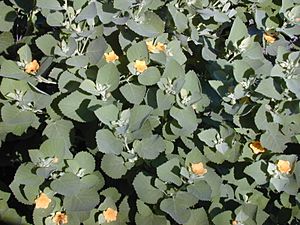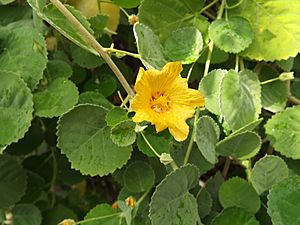Sida fallax facts for kids
Quick facts for kids Sida fallax |
|
|---|---|
 |
|
 |
|
| Scientific classification | |
| Genus: |
Sida
|
| Species: |
fallax
|
Sida fallax, also known as yellow 'ilima, is a type of flowering plant. In the Hawaiian language, it is called ʻilima. This plant belongs to the Hibiscus family, called Malvaceae. You can find it on some Pacific Islands.
These plants can grow straight up or spread out along the ground. They usually grow in dry, sandy areas, often close to the ocean. The ʻilima flower is a special symbol for the island of Oʻahu. It is also known as Kio in Marshallese.
What Does 'Ilima Look Like?
The flowers of the ʻilima plant are small. They are about 0.75 to 1 inch (1.9 to 2.5 cm) wide. Each flower has five petals and is a beautiful golden yellow color.
ʻIlima plants can grow to different heights. They can be as short as 6 inches (15 cm) or as tall as 10 feet (3 meters). Some forms grow flat on the beach, while others grow as upright shrubs in the mountains.
The ʻilima that grows near the beach is called ʻilima papa. It has leaves that look silver-green. Mountain varieties have smooth, green leaves. The leaves can be long and thin, or they can be round or heart-shaped. Their edges can be slightly or deeply jagged. The flowers can grow alone or in small groups.
How People Use 'Ilima
Native Hawaiians traditionally used ʻilima flowers to make beautiful leis. A lei is a necklace made of flowers. In the past, ʻilima leis were often worn by Hawaiian royalty. Today, anyone can wear them.
Sometimes, the flowers are also used to decorate food. People also used S. fallax as a medicine in the past. In tropical places, this plant is sometimes grown as a groundcover. This means it spreads out to cover the ground.
See also
 In Spanish: Sida fallax para niños
In Spanish: Sida fallax para niños

